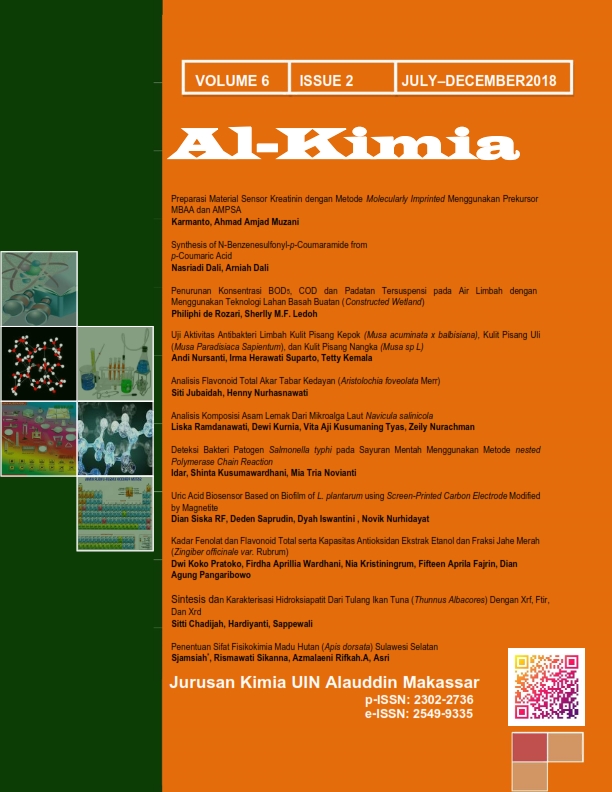Deteksi Bakteri Patogen Salmonella typhi pada Sayuran Mentah Menggunakan Metode nested Polymerase Chain Reaction
Abstract
Salmonella typhi (S. typhi) infection is a zoonotic infection and known as salmonellosis. In the human body, salmonellosis causes an increase in high body temperature or known as typhoid fever that cause high morbidity and mortality in developing countries, especially Indonesia. It was found that out of 22 million cases of typhoid fever, 200 thousand of them ended in death. S. typhi often contaminates food that was consumed raw or not perfectly cooked, for example meat, eggs, dairy products, fruits and vegetables. The conventional method for detecting these bacteria is culture method which time consuming and need BSL 2 facilities. PCR was one of DNA based detection method that could overcome the culture method weakness. In this study conducted detection of Salmonella bacteria in raw vegetables which are usually consumed as fresh by using nested PCR method. The detection procedures were sample preparation; bacterial DNA isolation; amplification by using two sets of primer, ST1-ST2 in first round PCR and ST3-ST4 in second round PCR; and the characterization by using agarose electrophoresis. The results indicated that two of nine raw vegetables, tomatos and cabbages have been contaminated with Salmonella. We conclude that nested PCR could detect Salmonella contamination in raw vegetables.Downloads
References
Ahmed O. B., Asghar A. H., El-Rahim I. A. & AI H. (2014). Detection of Salmonella in Food Samples by Culture and Polymerase Chain Reaction Methods. J Bacteriol Parasitol, 5(3): 1-3.
Barakat S. M. Mahmoud. (2011). Salmonella – A Dangerous Foodborne Pathogen. InTech: Croatia
Bharmoria A., Shukla A. and Sharma K. (2017). Typhoid Fever as a Challenge for Developing Countries and Elusive Diagnostic Approaches Available for the Enteric Fever. Int J Vaccine Res, 2(2) : 1-16.
Charles R. C., Sheikh A., Krastins B., Harris J. B., Bhuiyan M. S., LaRocque R. C., Logvinenko T., Sarracino D. A., Kudva I. T., Eisenstein J., Podolsky M. J., Kalsy A., Brooks W. A., Ludwig A., John M., Calderwood S. B., Qadri F., &. Ryan E. T. (2010). Characterization of Anti-Salmonella enterica Serotype Typhi Antibody Responses in Bacteremic Bangladeshi Patients by an Immunoaffinity Proteomics-Based Technology. Clinical and Vaccine Immunology, 17(8) : 1188–1195.
Chin C. F., Lai J. Y., Choong Y. S., Anthony A. A., Ismail A. & Lim T. S. (2016). Delineation of B-cell Epitopes of Salmonella enterica serovar Typhi Hemolysin E: Potential antibody therapeutic target. Scientific Reports, 7.
Crump J. A., Luby S. P., Mintz E. D. (2004). The global burden of typhoid fever. Bull World Health Org, 82 : 1-24.
Goay Y. X., Chin K. L. dan Tan C. L. L., Yeoh C. Y., Ja’afar J. N., Zaidah A. R., Chinni S. V., and Phua K. K. (2016). Identification of Five Novel Salmonella Typhi-Specific Genes as Markers for Diagnosis of Typhoid Fever Using Single-Gene Target PCR Assays. BioMed Research International, 1-9.
Hasan B., Nahar S. G., Shamsuzzaman A. K. M., Aftab S., Yusuf A. (2013). Detection of anti-salmonella antibodies by Immunochromatographic assay at Rajshahi Medical College, Bangladesh. J. Microbiol. Antimicrob, 5(11) : 119-123.
Hatta, M., Sultan, A. R., Pastoor, R. & Smits, H. L. (2011). New Flagellin Gene for Salmonella enterica serovar Typhi from the East Indonesian Archipelago. Am. J. Trop. Med. Hyg, 84(3) : 429-434.
Hayati A. S., Shah S. I. A., Shaikh N. (2011). Evaluation of Typhidot (IgM) in early and rapid diagnosis of typhoid fever. Professional Med J, 18(2) : 259-264.
Krishna S., Desai S., Anjana V. K., Paranthaaman R. G. (2011). Typhidot (IgM) as a reliable and rapid diagnostic test for typhoid fever. Ann. Trop. Med. Public Health, 4(1): 42-44.
Lee K. M., Runyon M., Herrman, T. J., Phillips R., Hsieh J. (2015). Review of Salmonella detection and identification methods: Aspects of rapid emergency response and food safety. Food Control, 47 : 264-276.
Ong, E. B. B., Anthony, A. A., Ismail, A. & Lim, T. S. (2013). Cloning, expression, and purification of the hemolysin/cytolysin (HlyE antigen) from Salmonella enterica serovar Typhi: potential application for immunoassay development. Diagn. Microbiol. Infect. Dis, 77 : 87–89.
Song J. B., Cho H., Park M. Y., Na D. S., Moon H. B., & Pat C. H. (1993). Detection of Salmonella typhi in the Blood of Patients with Typhoid Fever by Polymerase Chain Reaction. Journal of Clinical Microbiology, 31(6) : 1439-1443.
Wallace, A. J. (2000). E. coli hemolysin E (HlyE, ClyA, SheA): X-ray crystal structure of the toxin and observation of membrane pores by electron microscopy. Cell, 100 : 265–276.
Copyright (c) 2018 Idar Idar

This work is licensed under a Creative Commons Attribution-NonCommercial-ShareAlike 4.0 International License.
Authors who publish with this journal agree to the following terms:
1) Authors retain copyright and grant the journal right of first publication with the work simultaneously licensed under a Creative Commons Attribution License that allows others to share the work with an acknowledgement of the work's authorship and initial publication in this journal.
2) Authors are able to enter into separate, additional contractual arrangements for the non-exclusive distribution of the journal's published version of the work (e.g., post it to an institutional repository or publish it in a book), with an acknowledgement of its initial publication in this journal.
3)Authors are permitted and encouraged to post their work online (e.g., in institutional repositories or on their website) prior to and during the submission process, as it can lead to productive exchanges, as well as earlier and greater citation of published work (See The Effect of Open Access).


